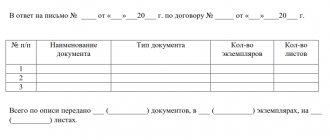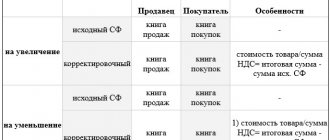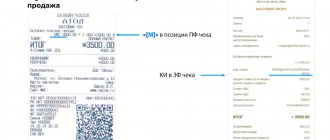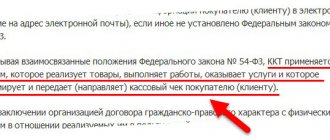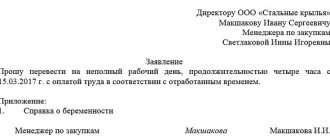The purpose of this act is to confirm the event of transfer of a certain product from one person or organization to another. Most often, the basis for the act is a concluded commission or custody agreement.
The sale of goods, as a rule, is accompanied only by a consignment note under the number TORG-12, if the conditions do not require the signing of the act.
Files for download:
In 2021, you need to draw up an act of acceptance of the transfer to record the transfer of values from one party to the other. There is no unified form of the act; companies have the right to develop it independently. In the article you will find a sample act of acceptance and transfer of goods in 2021. Read below for more details on how to do this.
Individual conditions for concluding an act
In some cases, organizations or persons drawing up the act may change the conditions at their own discretion. All conditions are designed to exclude claims of both parties, therefore additional clauses may be included in the act to keep the goods in their original form and prevent loss. All participants signing the deed must read and agree to these terms.
Another case when drawing up an act of acceptance and transfer of goods is inevitable - sending it for safekeeping. Here, an act is created in order to record the appearance, condition, technical characteristics of the transferred material assets, as well as indicate the conditions for their storage and appoint an employee responsible for safety.
In what cases is an acceptance certificate required?
Acceptance of goods only according to the TORG-12 invoice form assumes that the products listed in it have been delivered and correspond to the quantity specified in the documents. However, there are often situations when the actual volume of goods differs from the declared one, the wrong cargo arrived that was required, or the batch turned out to be defective. In order to make a claim to the supplier, these facts must be recorded properly, namely, by drawing up an acceptance certificate stating all detected inconsistencies.
Some types of products (for example, equipment) are always transferred under an act, since this is required by the process of their acceptance: inspection, performance testing, etc. If the goods are sent for safekeeping, an act is drawn up to describe the condition of the valuables being handed over, determine the conditions of their maintenance and appoint a materially responsible person.
When concluding a supply contract, the parties themselves can include in it a clause on the mandatory signing of a document on acceptance of the goods at the time of their transfer to the customer.
Documents instead of a deed: are there alternative options?
If the purchase and sale agreement is a mandatory document that certifies the agreement of the parties, defines their rights, obligations, the procedure for possible pre-trial settlement of disagreements and other important points, then instead of the act, you can draw up a consignment note . Essentially, the document should contain the same information:
- information about the parties;
- information about the product;
- dates, full names, names of organizations, signatures.
Thus, the fact of transfer of commodity values from one party to another can be confirmed by one of two documents (at the choice of the parties themselves) - either a deed or an invoice. In a legal sense, they perform similar roles.
It is often believed that a deed can be drawn up instead of the main purchase and sale agreement, which is a misconception. In fact, an agreement is the main document confirming the terms of the agreement, subject matter, rights and obligations, etc. The act is only an annex to the agreement, i.e. an integral part of it, but cannot in any way replace the basic agreement.
NOTE. In some cases, drawing up an act is mandatory, since it is extremely important for the document to reflect a description of specific claims or the absence thereof. For example, when complex equipment, mechanisms and other technical devices are purchased, there is no alternative to the act.
Thus, drawing up an act upon acceptance and transfer of goods is a guarantee that the parties really agreed on their actions and carried out acceptance in full accordance with the contract, without claims against each other.
How to draw up an act of transfer of goods
The act of acceptance and transfer of goods is usually attached to the supply agreement as its integral part. The standard form of the act contains the following data:
- document's name;
- date and place of registration;
- information about the parties to the transaction with details, addresses and contacts;
- Full names of the responsible persons, their passport details, on what basis the parties represent them;
- number and date of the contract under which the delivery is carried out;
- a list of transferred values indicating the range and quantity;
- quality characteristics of the product;
- total cost;
- presence/absence of product defects;
- a detailed list of detected deficiencies;
- claims based on the results of the acceptance procedure.
By agreement of the parties, the act may also reflect other issues:
- terms of payment for the delivered consignment of goods (full or partial prepayment, settlements after receipt of the goods);
- deadlines for final payments, numbers and dates of payment documents for advances;
- inclusion of certain product groups and specific items in separate acts.
In what form should it be compiled?
The unified form of the act of acceptance and transfer of material assets has not been approved; the organization is developing it independently. The form adopted by the organization should be approved in the accounting policy for accounting purposes based on the recommendations of the Ministry of Finance set out in Information No. PZ-10/2012. The form may be an integral part of the contract, an appendix to it, in which case it is binding on each of the parties, regardless of the form approved in its accounting policy.
How to correctly draw up a transfer and acceptance certificate
Since the act is a two-sided document, it must contain the signatures of representatives of both the supplier and the recipient of the cargo. Before you begin accepting the goods, you must make sure that the persons present from each party have the authority to endorse the transfer deed. Confirmation can be:
- power of attorney issued to an employee of the company by the head;
- order of appointment to a position with the right to act on behalf of the organization;
- a notarized order for an individual representing a party to the transaction.
To document the fact of receipt of products under the contract, you must:
- and bring it into compliance with the terms of delivery: remove unnecessary information, add items provided for in the contract.
- As a rule, goods are accepted in warehouse conditions, so it is better to print out the prepared form for manual filling in 2 copies in advance.
- Carry out the necessary activities: external inspection, recalculation, weighing, reconciliation of positions, etc., depending on the type of product and the features of the established acceptance and transfer procedure.
- Record all detected defects in the presence of the supplier’s representative and list them in the report.
- Formulate the essence of the claims; if there are none, confirm this in writing: “We have no claims.”
- Agree on the contents of the document and check that it is filled out correctly.
- Confirm the act with the signatures and seals of the parties.
Inaccuracies, blots and errors in transfer documents are unacceptable. If an error is found in the act, it must be redone before signing.
The acceptance certificate, stating that the goods were delivered with violations, with complaints about quality, is the basis for drawing up a letter of claim to the seller demanding a replacement batch and monetary compensation. Defective products are sent to the supplier using a return certificate (form TORG-2) indicating the reason for the return shipment and a detailed description of all defects.
If the cargo was lost or damaged during transportation, the issue of compensation for losses is decided on the basis of the contract - whether it provides for compensation for losses in such cases.
To correctly draw up a document, download a sample goods acceptance certificate.
Legal subtleties
There are a number of points that you should pay attention to before drawing up an APP for goods:
- The act is an addition to the agreement, and not an independent document (with a reference). If there is no agreement, then the act loses legal force.
- Signatures of the parties are required. Otherwise, the APP cannot be considered concluded. But the seal of organizations is not mandatory; you can do without it.
- The transfer and acceptance certificate is drawn up in 2 copies - one for each of the interested parties to the transaction.
- Various annexes (storage conditions, delivery times) can be an addition to the AMS.
- Offsets must be in rubles - but if, on the one hand, the foreign organization is not on the territory of the Russian Federation, the currency may be different. True, in this case it is better to register both national monetary units.
- The storage period for the transfer and acceptance certificate is 5 years after the year of reporting.
So, a deed of transfer is not always mandatory, but no one prohibits its execution. It allows you to record the moment of transfer of goods from the supplier (manufacturer) to the recipient (customer), and also serves as evidence in case of litigation
Peculiarities of drawing up the transfer and acceptance certificate in atypical cases
We examined the preparation of a transfer deed in the case of direct shipment from the seller to the buyer in the territory of one of the parties. If a third party is involved in the delivery process, they also become an interested party.
Documents for the transfer of goods stored in a warehouse of a third-party organization are filled out in triplicate: for the supplier, the customer and the owner of the warehouse. Additional copies of the acts may be required by the carrier company, security company hired to accompany the transportation, etc.
A separate issue is the delivery of products for safekeeping. In this case, as an act of acceptance and transfer of goods, a document is drawn up on a unified form MX-1, which is signed by two parties: the owner of the cargo and the receiving organization. The basis for placing goods in a third-party warehouse is a custody agreement, which determines the quantity and cost of transferred products, the number of deliveries and other conditions.
The law does not impose requirements for the presence of a transfer deed if there is an invoice for the goods signed by the parties, however, in the event of controversial situations, this document has legal force in court.
General rules regarding acceptance of goods
Upon receipt of the ordered products at the enterprise or store, they are accepted. This is a process that consists of the following stages:
- checking the quality, quantity and completeness of received products;
- preparation of necessary supporting documents;
- acceptance of products for registration.
All delivery verification activities are carried out by experienced employees who are financially responsible. They must have knowledge of the regulatory framework regarding the timing and rules for product acceptance, understand quality indicators and quantitative assessment of the product, and be able to correctly draw up the required documentation. If the acceptance procedure for quality and completeness is carried out carelessly or with violations, then the chances of making justified claims to transport companies or manufacturers are sharply reduced.
When receiving the cargo, the responsible person is obliged to make sure that the characteristics of the product (price, quantity, name) indicated in the accompanying documents correspond to the actual state of affairs. The following documents may be attached to the cargo under the supply contract:
- Consignment note . Used to formalize the sale of products to third parties. One copy remains with the supplier, the other is transferred to the buyer for registration.
- Consignment note . As a rule, it is used for delivery by road transport and is drawn up in 4 copies. Includes two sections: commodity (regulating the relationship between the recipient and the sender) and transport (determining the relationship of the transport enterprise with the shipper). One copy is needed for receipt of cargo in a store or warehouse.
- Check . Issued by the company that supplied the product, and is the basis for the transfer of money, since it certifies the price and fact of delivery of the product.
- Invoice . It differs from a regular invoice in that it contains detailed information about each type of product (name, price of each type of product, transport document numbers, total amount to be paid). It is convenient to work with an invoice if the list of items of supplied products is extensive.
In addition, you need to study the contents of other papers, in particular, about certification (for those types of products that must be certified) and expiration dates (if it must be present).
If no problems arise, the recipient's representative signs the accompanying documents and puts a round seal on them.
Sometimes you hear discussions about whether acceptance and posting are the same thing or not. There are different opinions on this matter. Some experts argue that these are identical concepts, since the result of their implementation is an increase in the amount of product remaining in warehouses. Others say that when a product is accepted, this is confirmed by a receipt, indicating that this product or material was purchased from a specific seller. Based on the results, either money is transferred to the supplier’s account or the products are returned. Capitalization is an integral part of inventory, when unaccounted for, but available goods are placed on receipt. Therefore, it is concluded that the acceptance of goods into the warehouse confirms the purchase of the product, and capitalization is carried out only if unaccounted for cargo is identified in the warehouse.
